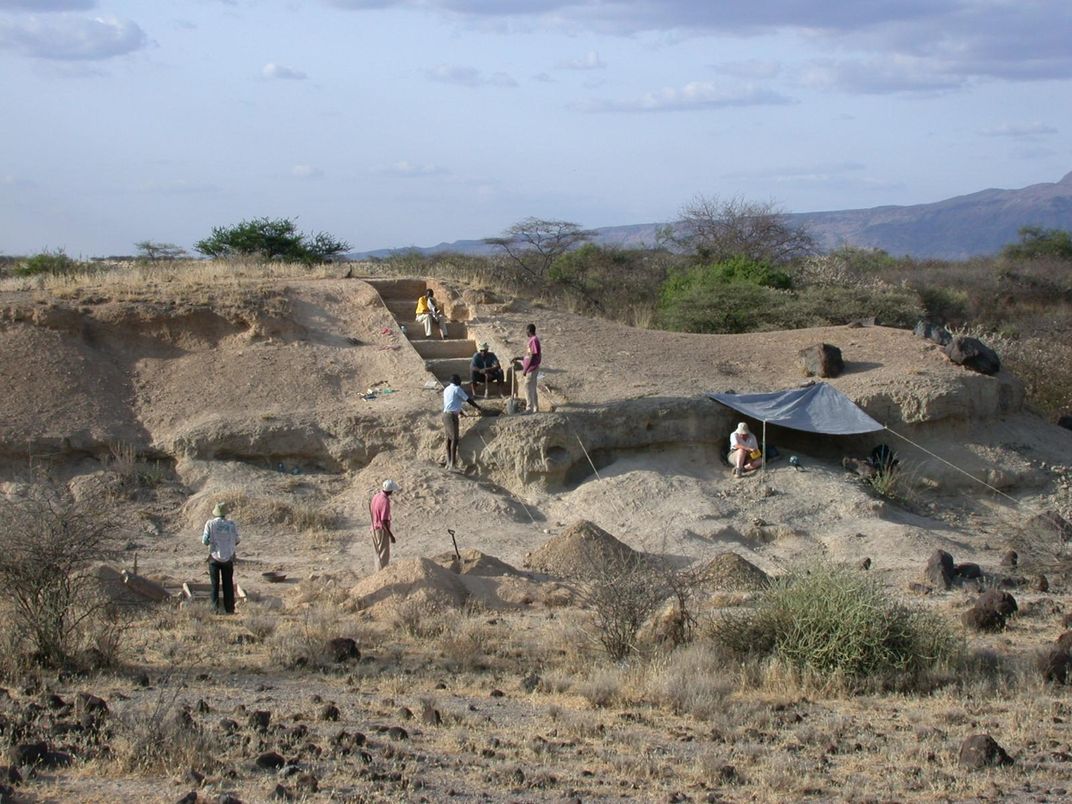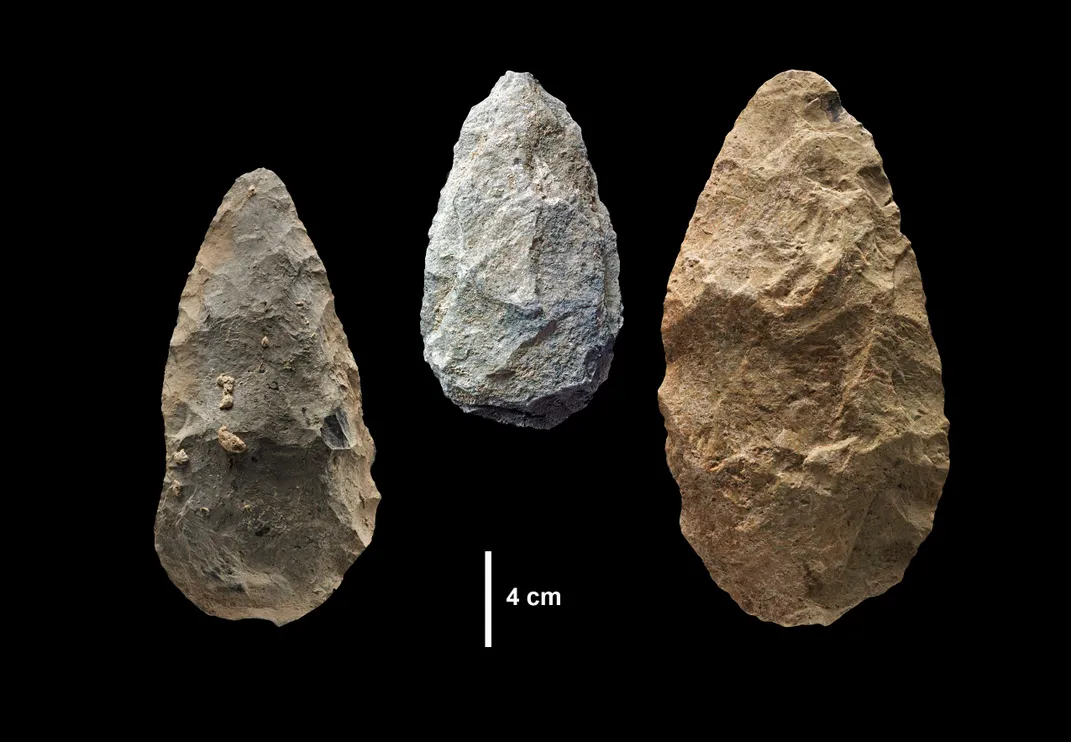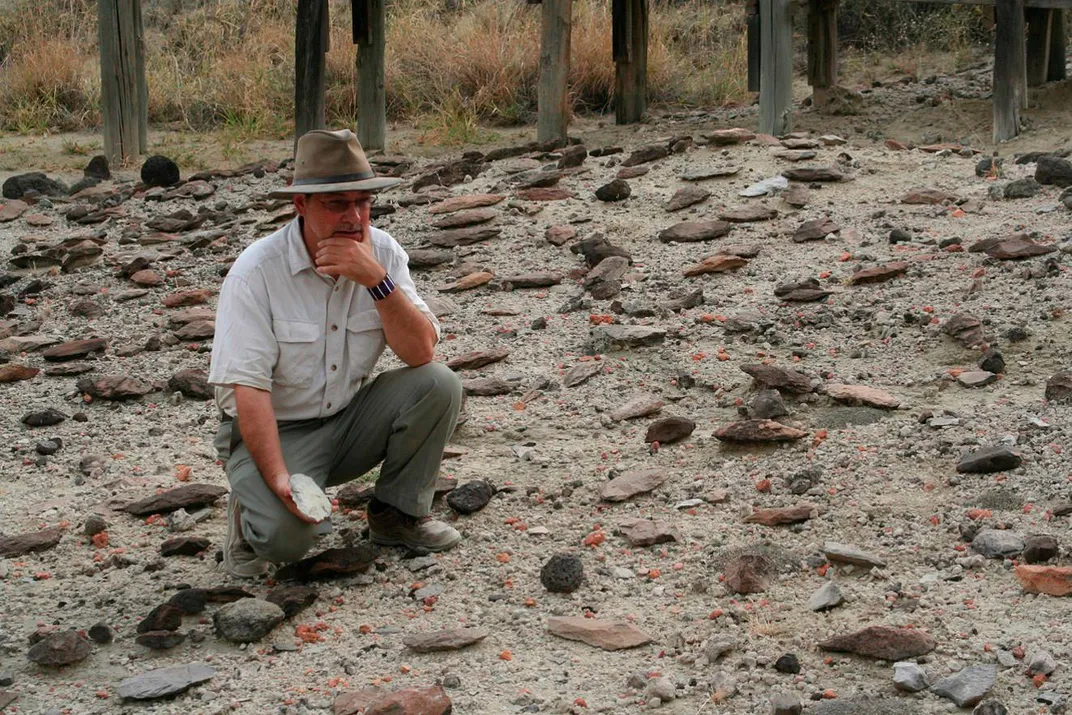Colored Pigments and Complex Tools Suggest Humans Were Trading 100,000 Years Earlier Than Previously Believed
Transformations in climate and landscape may have spurred these key technological innovations
/https://tf-cmsv2-smithsonianmag-media.s3.amazonaws.com/filer/b4/33/b4339aa2-3a1c-40ab-8c9a-4fe7a5594ffb/potts1hr-wr.jpg)
What the heck are these? thought Rick Potts. The Smithsonian paleoanthropologist was looking at a small, round, charcoal-colored lump. The stubby rock was accompanied by 85 others, all excavated from the Olorgesailie Basin site in southern Kenya.
Over the past decade, the site had revealed a bevy of finds to Potts and his team of researchers from the Smithsonian and the National Museums of Kenya, including thousands of hominin-made tools, fossilized mammal remains and sediment samples spanning hundreds of thousands of years. But the lumps were a mystery.
Back at the lab, researchers analyzed them to find that they were black pigments: The oldest paleo-crayons ever discovered, dating back to around 300,000 years ago.
That was only the beginning of the intrigue. Having long studied this site and this period in human evolution, Potts knew that early humans generally sourced their food and materials locally. These “crayons,” however, were clearly imported. They’d formed in a briny lake, but the closest body of water that fit that description was some 18 miles away. That was much farther than most inhabitants likely would’ve traveled on a regular basis, given the uneven terrain. So what was going on?
The pigments, Potts and his co-authors now believe, were part of a prehistoric trade network—one that existed 100,000 years earlier than scientists previously thought.

In addition to the pigment lumps, the researchers point to the transformation in stone tool technology as proof of this claim. At the same site, they found thousands of newer tools made from materials that had been transported over long distances. They report these findings in a series of three related papers out today in Science; in addition to Potts, lead authors include Alan Deino, a geochronologist at the University of California at Berkeley, and paleoanthropologist Alison Brooks of George Washington University.
“The earliest evidence for Homo sapiens in eastern Africa is about 200,000 years ago, so this Middle Stone Age evidence we’re finding is significantly before that,” says Potts, who is the director of the National Museum of Natural History's Human Origins Program and has been leading research in Olorgesailie for more than 30 years. “[Early humans] were rare in their environment based on the fossil record itself, but left these durable calling cards behind, these stone tools. So we know a lot more about the transition in behavior than we do the timing or who actually made these tools.”
These complex behavioral changes signal a major shift in cognition, which may have given modern humans an edge over other hominin lineages out there. The researchers even offer a possible explanation for the shift: Environmental instability. By examining markers of change in the surrounding environment, researchers find that this profound cognitive leap happened at the same time as dramatic transformations in climate and landscape.
The transition in question at Olorgesailie stretches from 500,000 years ago to 300,000 years ago. At the start of that shift, the dominant hominin was Homo erectus, the oldest known early humans who first appeared around 1.8 million years ago and spread across the world. The “upright man” is often accompanied by the handaxe, a stone tool that has been discovered at sites in Africa, Asia and Europe. The pear-shaped stone tools belong to a tool technology tradition known as the Acheulean, which lasted more than a million years.
But sometime around 500,000 years ago, these handaxes started looking a bit more refined, says cognitive archaeologist Derek Hodgson of the University of York, who was not involved in the new research. “You get three-dimensional symmetry in the handaxes, as if the hominins are able to rotate the object in the minds’ eye, which is a very complex skill to achieve,” Hodgson says. “These tools seem too refined, and some are far too large for functional needs.” In other words, these later tools might have been used to indicate social status, or for aesthetic purposes.
Potts and his team at Olorgesailie also observed this evolution in handaxes. What began as strictly functional tools made from local stone were gradually infiltrated by the occasional smaller tool and transported material. By 300,000 years ago, the transition at Olorgesailie was complete. Handaxes had essentially disappeared, leading to a new technological era called the Middle Stone Age—and a new kind of hominins wielding those smaller tools.

When and why this change happened, and who was behind it, has been debated for years. The challenge in the past has been the lack of record. “The attempt to pin down the timing and circumstances of this process suffers from a number of conceptual and practical difficulties,” write archaeologists Sally McBrearty and Christian Tryon in a 2006 paper. Namely, archaeologists have never been able to find archaeological sites with continuous sediment layers spanning that transition, likely because the Rift Valley was undergoing such enormous tectonic disruptions.
The Olorgesailie Basin sediments suffer from the same missing gap, which stretches from 499,000 years ago to 320,000 years ago. What happened in those mysterious years is still up for debate. But what emerged on the other side at Olorgesailie is something never before seen at such an early date: Humans who had the social and cognitive skills to create refined tools; long-distance trade networks to obtain optimum tool-making materials, like obsidian; and the adaptability to survive in an environment that included earthquakes, volcanoes and wildly fluctuating wet-dry cycles.
So did the tools themselves spur the neurological change, or did the larger brains of Homo heidelbergensis—who usurped the hominin throne from Erectus and is believed to be the shared ancestor of Homo sapiens and Neanderthals—allow for the creation of these new tools? It’s a query the physical remains can’t quite answer. “It’s kind of like, were humans really smart before there were computers?” Potts says. “That’s a major invention, and yet obviously we’re the same people before computers as after."
Hodgson agrees that neural networks probably had to be in place for the creation of new tools, and maybe those neural networks were also related to new social behaviors like trade alliances and pigment use. But understanding the relationship between humans and their unpredictable environment is still a crucial piece of the puzzle.

The Great Rift Valley is named for its location atop an intra-continental ridge system that has been tectonically active for millions of years. During the transition the team was studying, there was also a move to a drier environment with intervals of humidity. Animals, plants, landscapes were shifting: By examining the faunal fossil record, Potts and his team found that 85 percent of mammal species experienced local extinction during that transition between the Acheulean and the Middle Stone Age.
These enviromental challenges may have pushed humans toward greater cooperation and exploration. “If it was every hominin for itself, that would have been a disaster, and that could’ve been one of the reasons why the Acheulean way of life disappeared,” Potts says. Maybe that’s why the Middle Stone Age peoples in Olorgesailie got 50 to 60 percent of their tool-making materials from far away—they used trade as a means of survival.
It’s an intriguing narrative, but researchers still need to fill in the gaps in the geologic record to verify it. Which is exactly what's on the horizon for Potts, and for paleogeologists like Andrew Cohen, a professor of geosciences, ecology and evolutionary biology at the University of Arizona who has worked with Potts in the past. Cohen leads the Hominin Sites and Paleolakes Drilling Project and has submitted work based on core samples from the region, which will further elucidate our knowledge of local climate fluctuations.
“The finding of a fairly continuous record of the late Acheulean into the Middle Stone Age is a spectacular find,” Cohen says of Potts’ work. “Trying to narrow down the timing of the transition is a pretty big step forward.” He hopes to add on to the next step with much more detailed climactic records for the same time and same place.
This kind of research does more than help us understand where we came from. Studying these milestones in humanity's past, says Cohen, could help us prepare for a future in which Earth's climate is once again unpredictable. “We’ve got 10 or perhaps more species of hominids out there, and they all went extinct for reasons that we don’t understand,” Cohen says. “I think it’s imperative that we try to understand them. It’s not just an evolutionary event—it’s also extinction events.”
/https://tf-cmsv2-smithsonianmag-media.s3.amazonaws.com/accounts/headshot/lorraine.png)
/https://tf-cmsv2-smithsonianmag-media.s3.amazonaws.com/accounts/headshot/lorraine.png)